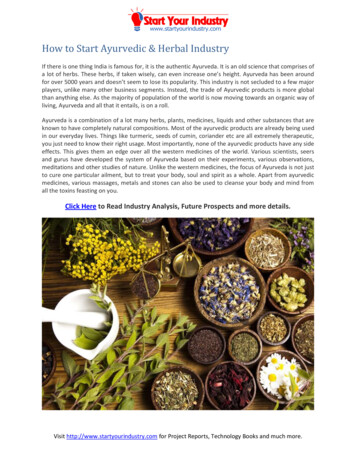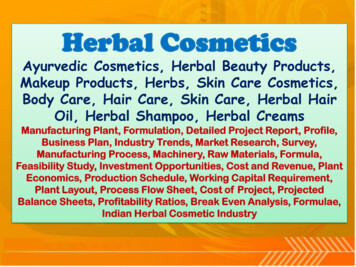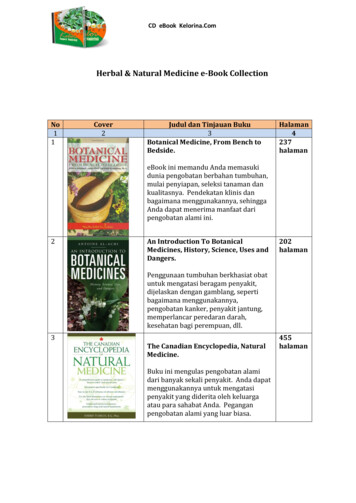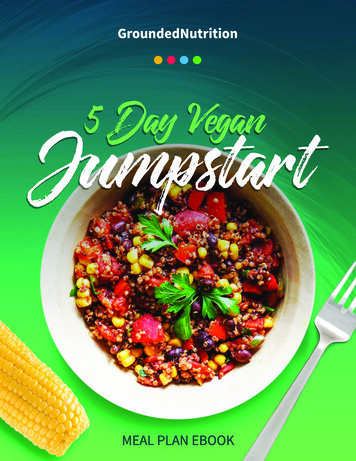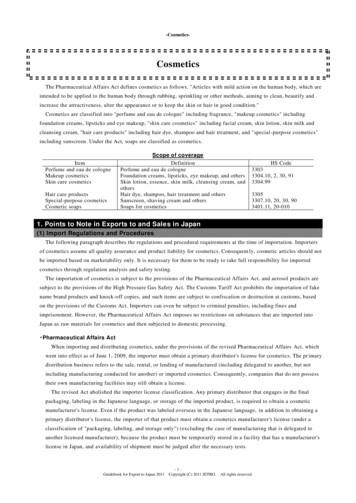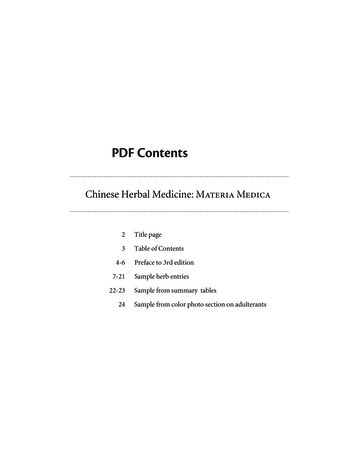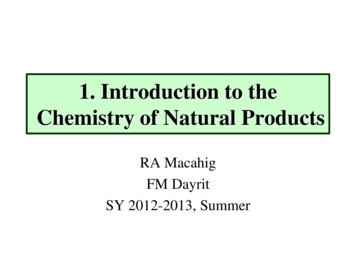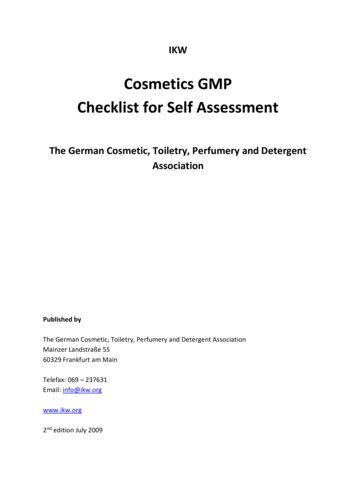
Transcription
HERBAL COSMETICS1. INTRODUCTIONThe concept of beauty and cosmetics dates back to ancient mankind andcivilization. Generally herbal cosmetics are also referred to as naturalcosmetics. Herbal cosmetics are formulated, using different cosmeticingredients to form the base in which one or more herbal ingredients are usedto cure various skin gproductsforcosmeceuticals and pharmaceutical applications. Herbal cosmetics are theproducts in which herbs are used in crude or extract formAll human being have urge to look beautiful. It is because of this reason thatthey have been using different types of materials from time immemorial. Inearly period cosmetics were associated with religious practices. It is almosttrue for all old civilizations like Indian, Chinese, and Egyptian & Greek. Ubtanwith flour, turmeric and vegetables oil before marriage is still practiced inIndia. Kum Kum is still being applied by women. During the early period, allcosmetics items were made in the home. Natural materials like aromaticmaterials, spices, herbs, resins, dyes, fats, oils, and the natives of differentcountiesusedperfumes.The herbal products/ drugs are derived from vegetable sources from variousparts of the plants like root, leaf; flower fruit extrude or plant as a whole.There are three kinds of ingredients used in herbal products1.Herbal2.Mineral and3.Animal2. PRODUCT AND ITS APPLICATION
In India, alternate system, commonly referred to as “Indian system ofMedicine and Homeopathy” (ISM&H) includes Ayurveda Siddha Unani and HomeopathyThis particular project profile focuses is mainly on AyurvedaHerbal Cosmetics, referred as Products, are formulated, using variouspermissible cosmetic ingredients to form the base in which one or moreherbal ingredients are used to provide defined cosmetic benefits only, shallbe called as “Herbal Cosmetics”.Herbs do not produce instant cures. They offer a way to put the body inproper tune with nature A huge number of cosmetic and toiletry formulationshave been designed and developed based u p o n Indian Herbs recently.Other than traditionally documented applications, some modern trials havealso been using the utility of Indian herbs in Personal Care products.
The demand of herbal medicines is increasing rapidly due to their skinfriendliness and lack of side effects. The best thing of the herbal cosmetics isthat it is purely made by the herbs and shrubs and thus is side-effects free.The natural content in the herbs does not have any side effects on the humanbody; instead provide the body with nutrients and other useful minerals.The term Cosmeceuticals was first used by Raymond Reed founding memberof U.S Society of Cosmetics Chemist in 1961. He actually used the word tobrief the active and science based cosmetics. The above term was further
used by Dr Albert Kligman in the year 1984 to refer the substances that haveboth cosmetic and therapeutic benefits. Cosmeceuticals are cosmeticpharmaceutical hybrids intended to enhance health and beauty throughingredients that influence the skin's biological texture and function3. DESIRED QUALIFICATION FOR PROMOTERThe promoter should ideally be having formal qualifications in the field ofAyurveda (Bachelor or Diploma). A formal qualification in Cosmeceuticals mayalso do. Further he / she should have experience of working in a unitmanufacturing Herbal products.4. INDUSTRY OUTLOOK/TRENDHerbal cosmetics are the modern trend in the field of beauty and fashion.These agents are gaining popularity as nowadays most women prefer naturalproducts over chemicals for their personal care to enhance their beauty asthese products supply the body with nutrients and enhance health andprovide satisfaction as these are free from synthetic chemicals and haverelatively less side-effects compared to the synthetic cosmetics.5. MARKET POTENTIAL AND MARKETING ISSUES, IF ANYThe demand of herbal cosmetics is increasing rapidly due to their skinfriendliness and lack of side effects.Herbal cosmetics are the modern trend in the field of beauty and fashion.These agents are gaining popularity as nowadays most women prefer naturalproducts over chemicals for their personal care to enhance their beauty asthese products supply the body with nutrients and enhance health andprovide satisfaction as these are free from synthetic chemicals and haverelatively less side-effects compared to the synthetic cosmetics.
Following are some of the advantages of using natural cosmetics which makethem a better choice over the synthetic ones:Natural productsThe name itself suggests that herbal cosmetics are natural and free from allthe harmful synthetic chemicals which otherwise may prove to be toxic to theskin. Instead of traditional synthetic products different plant parts and plantextracts are used in these products, e.g. aloe-Vera gel and coconut oil.They also consist of natural nutrients like Vitamin E that keeps skin healthy,glowing and beautiful. For example, Aloe Vera is an herbal plant speciesbelonging to liliaceae family and is naturally and easily available. There are arising number of consumers concerned about ingredients such as syntheticchemicals, mineral oils who demand more natural products with traceableand more natural ingredients, free from harmful chemicals and with anemphasis on the properties of botanicalsSafe to useCompared to other beauty products, natural cosmetics are safe to use.They are hypo-allergenic and tested and proven by dermatologists to be safeto use anytime, anywhere. Since they are made of natural ingredients, peopledon’t have to worry about getting skin rashes or experience skin HT(ButylatedHydroxytoluene) are closely related synthetic antioxidants and are used aspreservatives in lipsticks and moisturizers BHA and BHT can induce allergicreactions in the skin. The international Agency for Research on Cancerclassifies BHA as a possible human carcinogen. Herbal cosmetics containnatural antioxidants like vitamin CCompatible with all skin types
Natural cosmetics are suitable for all skin types. No matter if you are dark orfair, you will find natural cosmetics like foundation, eye shadow, and lipstickwhich are appropriate irrespective of your skin tone. Women with oily orsensitive skin can also use them and never have to worry about degradingtheir skin condition. Coal tar-derived colors are used extensively in cosmetics,Coal tar is recognized as a human carcinogen and the main concern withindividual coal tar a color (whether produced from coal tar or synthetically) isthey can cause cancer but natural colors that are obtained from herbs aresafer.Wide selection to choose fromNatural cosmetics may still be a new type in the beauty industry but theyalready offer a variety of beauty products for all make up crazy people outthere to choose from. One will find a variety of foundation, eye shadow,lipstick, blush, mascara, concealed and many more which are all naturallyformulated. Furthermore, one will find locally made natural cosmetics orthose made by famous designers worldwide. There exist a large variety Kalmegh),Asparagus Racemosus (Shatawari), Boswellia Serrata (Salai Guggal), Asphalt(Shilajit) etcFits your budgetNatural cosmetics are not that expensive. In fact, some of these products aremore affordable than synthetic ones. They are offered at discounted pricesand are sold for a cheap price during sales. Just need to survey enough tolook for great deals.An estimate of WHO demonstrates about 80% of world population dependson natural products for their health care, because of side effects inflicted andrising cost of modern medicine. World Health Organization currentlyrecommends and encourages traditional herbal cures in natural health careprograms as these drugs are easily available at low cost and arecomparatively safe
Cosmeceuticals‘Cosmeceuticals’ is fastest growing segment of the beauty industry.Cosmeceuticals are cosmetic-pharmaceutical products intended to improvethe health and beauty of the skin by providing a specific result, ranging fromacne-control and anti-wrinkle effects, to sun protection. The conceptdiscovered by Dr. Albert klingman states that ‘The Cosmeceuticals are topicalagents that are distributed acrossThe Indian herbal market consists of herbal products such as herbal hair care,herbal skin care & other herbal personal care products. Over the period of2008 and 2013, the herbal medicine market in the country grew at a CAGR of26.7%1. The growth of herbal products reflects the shifting trend ofconsumers from allopathic to herbal medicinesTable 01 Herbal Cosmetics available in Indian Market (Indicative)ProductFace WashShampooBrand nameDeep Cleansing Apricot Face WashAnti-DandruffShampoo-VolumeBounceHair oilAmla Brahmi hair oilCreamHerbal massage creamAnti Ageing Dabur Uveda Age Renew 5 creamCompanyHimalayaherbals& HimalayaherbalsAyur HerbalsAyur HerbalsDaburcreamSource: Herbal Cosmetics and Cosmeceuticals: An OverviewLaxmi S Joshi and Harshal A PawarMedicinal plants have been a major source of cure of human diseases sincetime immemorial. Today, one fourth of the world population depends ontraditional medicines. Despite the introduction of antibiotics since the 1940’s,
even 80 per cent of the population today relies on indigenous medicinalplants and the drugs. It is estimated that the global traditional medicinemarket is growing at the rate of 7-15 per cent annually. The medicinal plantvalue is about Rs.5000 crores in India and it is estimated that the countryexports about Rs.550 crore worth of herbal drugs but with the rich anddiverse botanical resources in our country, this is not an impressive exportperformance considering the worldwide herbal market worth US 60 billiondollars.In order to withstand competition in the global market, it is necessary tocreate a brand image, especially in Cosmeceuticals and natural products.Craze among the people for a slim body, fair skin as fashion is growingconsiderably. Out of the Rs.12, 000 crores industry, Rs.700 crores belongs toskincare products and Rs.100 crores for general cosmetics. Over and abovecurrent herbal drugs used in cardio vascular is 27%; respiratory 15.3%,digestive 14.4%; hypnotics and sedatives 9.3%; miscellaneous 12%. Theperfumery industry is also around Rs. 700 crores.Table 02 Herbal Cosmetics (Patented) in International MarketProductHerbal cream(Aloevera,Alliumsativum,Patent numberUS6200570 B1CountryUSAEP1825845 A1EUROPEDE4133085 A1GERMANYEP0908171 A1EUROPEGymnema syllvestra, Tridax procumbens, Gumolibanum)Herbal preparation(Bacopa monnieri, Camelliasinensis, Curcuma longa, Silybum marianum,Withania somnifera)Herbal cosmetic compositions containing herbsin mixture of surfactants, essential oils etc.Herbs are selected from camomile, rosemary,mint, sage, lavender, citron, bergamot, juniper,rose, lime (linden), stinging nettle and witchhazel.Dry herbal, cleaning compositions ( Bassicamalabarica, cocoa nucifera sapindus trifoliatus,
A2INTELLECTUAapplicationsparticularly to hair careLPROPERTYORGANISATION (WIPO)Source: Herbal Cosmetics and Cosmeceuticals: An OverviewLaxmi S Joshi and Harshal A PawarThe Indian herbal industry is likely to double from present Rs. 7,500 crore toRs. 15,000 crore by 2015, according to a new study published on Friday.The study, brought out by the Associated Chambers of Commerce andIndustry (ASSOCHAM) has viewed that the domestic herbal industry will growrapidly in the coming years and by 2015, it is expected that the size of thedomestic market will rise to Rs. 15,000 crore, reflecting a compound growthrate of over 20 percent.Releasing the study, ASSOCHAM Secretary General, D.S Rawat said thatideally, the niche market that India can focus on include Ayurvedic Medicinesand Dietary Supplements (including health drinks), extracts, Oils and otherderivatives, skin care and beauty aids.According to the study, the Indian domestic market can be broadlysegmented into two categories. The first one will cover raw materialsrequired by the industrial units and direct consumption for householdremedies, whereas the second category will cover ready to use finishedmedicines, health supplements etc.The study has found that there is a strong demand for raw stock which mainlycomprises Amla, Isabgol, Senna, Henna, Ashwagandha, Aloe-Vera andMyrobalans (Hartaki), which accounts for over 75% of the raw materials usedin Ayurvedic preparations. In terms of volume, it is estimated that current
consumption of the key raw ingredients (as mentioned above) totalsapproximately 400,000-500,000 MT.With value addition, the market for herbal based products is around Rs.7, 500crores, which is roughly the current size of the Indian market, it is stated.The study points out that globally the dependence on herbal medicines,dietary supplements and skin and beauty aids will continue to gain greatershare in view of the awareness and comfort level which is akin to the use oforganic food products.The ASSOCHAM study, however, is of the view out that India’s share in theglobal herbal market is very meagre considering the country’s rich source ofmedicinal plants and traditional treasure of knowledge in this area.A quick estimate of the potential reveals that India can generate raw stock ofaround Rs. 300 billion and easily achieve around Rs. 150 billion value addedproducts. Thus, India is hardly able to exploit less than 50% of its potential,the study adds.1. The Associated Chambers of Commerce and Industry of India(ASSOCHAM) has projected that the market size of herbal industrywhich is currently estimated at Rs. 7, 500 crores (Rs. 75 billion) willdouble to levels at Rs. 15, 000 crore by 2015 since this industry wouldbe growing at a compounded annual growth rate of over 20%henceforth.2. In a study brought out by ASSOCHAM on Herbal Industry and GlobalMarket 2015, it is pointed out that India’s rich source of medicinalplants and traditional treasure of knowledge in this area, its share atpresent is considered very meagre. A quick estimate of the potentialreveals that India can generate raw stock of around Rs. 300 billion andeasily achieve around Rs.150 billion value added products. Thus, Indiais hardly able to exploit less than 50% of its potential. Interestingly
both raw materials (herbs) and herbal products have ready marketglobally.6. RAW MATERIAL REQUIREMENTSA large number of herbs, medicinal plant extracts, etc would be required forthis project. This is because one particular formulation would have about 8 to10 active ingredients. Raw materials is different type of herbal lyglassbottles,andpapercontainers etc. is availableAll the raw materials such as herbs, minerals etc. for preparation of Ayurvedicmedicines are available in India abundantly, particularly in N.E. Region andHimalayan Range as a whole. States like Gujarat also have large biodiversityand availability of medicinal plants.To indicate following raw materials are requiredTable 03Herbal cosmetic productIndicative raw materialSkincareCoconut Oil , Sunflower Oil, Olive Oil, Aloe Vera, etc.Anti -agingDandruff treatmentRhodiola rosea-Rhodiola rosea, Carrot, Neem, , and Amalaki, Magic nut, Bringaraj, Rosary Pea,Hair careAnti OxidantsSweet Flag, Cashmere tree and MandorAmla, Eucalyptus OilTamarind,7. MANUFACTURING PROCESSRegulatory status of CosmeceuticalsCosmeceuticals - cosmetics or drugs?
The legal difference between a cosmetic and a drug is determined by aproduct’s intended use. Under present concept, the boundary at which acosmetic product becomes drug is not well-defined and different laws andregulations apply to each type of product.The Drugs and Cosmetic Act 1940 of India defines a drug and a cosmeticas; Drug-“ All medicines for internal or external use of human beings oranimals and all substances intended to be used for ; or in the diagnosis,treatment, mitigation or prevention of any disease or disorder in humans oranimals”. Cosmetic-“Any article intended to be rubbed, poured, sprinkled orsprayed on or introduced into or applied to any part of the human body forcleansing, beautifying, promoting attractiveness or altering the appearanceand includes any article intended for use as a component of cosmetic”Cosmetic and drug: Some products meet the definitions of both cosmeticsand drugs. This may happen when a product has more than one intendeduses. For example, a shampoo is a cosmetic because its intended use is toclean the hair. An antidandruff shampoo is a drug because its intended use isto treat dandruff. Among the cosmetic/drug combinations are toothpastesthat contain fluoride, deodorants that are antiperspirants and moisturizerswith sun-protection claimsThe claims made about drugs are subject to detailed analysis by the Foodand Drug Administration (FDA) review and approval process, but cosmeticsare not subject to mandatory FDA review. Although there is no legal categorycalled Cosmeceuticals, the term has found application to designate theproducts at the borderline between cosmetics and pharmaceuticals.Federal Food, Drug and Cosmetic Act do not recognize the term itself. It isalso often difficult for consumers to determine whether ‘claims’ about theactions or efficiency of Cosmeceuticals are valid unless the product has beenapproved by the FDA or equivalent agency. Some countries have the classesof products that fall between the two categories of cosmetics and drugs: forexample, Japan has ‘Quasi-drugs’; Thailand has ‘controlled cosmetics’ and
Hong Kong has ‘cosmetic-type drugs’. The regulations of Cosmeceuticalshave not been harmonized between the USA, European, Asian and othercountriesManufacturing processThere are so many types of herbal creams and other herbal body careproducts are available in the market. The manufacturing process of eachproduct is different.However, for the manufacture of creams and body lotion the general processof manufacture of cream and lotion is involved i.e. saponification of oil withmild alkali e.g. Bee-Wax. Paraffins, oils in alkali type material are heated atappropriate temperature to form creamy base. The base so formed can beadded aloevera some emulsifying preservative color perfume and otherstabilizing agent can be added in the last of manufacturing process. Forpreparation of herbal scrub all the herbs can be grinded into fine powder withthe help of pulveriser and it can be diluted with the help of fuller earth/masoor ki dal and other ingredients. All the ingredients are mixed together ina mixer and packed in desired size packs.8. MANPOWER REQUIREMENTSSr.DesignationNo.1Manager cum Manufacturing234567ChemistAnalytical ChemistSales representativeClerk cum AccountantSkilled WorkerUnskilled WorkerPeon cum ChowkidarSub TotalPerks @ 15 0009000400041000615047150/Say 47000/-9. IMPLEMENTATION SCHEDULE
Sr. No12ActivityPreparation of Project reportE M Registration & approval3Director of AyurvedaFinancial/Loan from Banker or FinancialTwo months4InstitutionsPower connection/Building constructionOne month567Six monthsMachinery procurement & Trial run.Recruitment of Staff & LabourActual commercial productionTwo monthsOne monthOne month10.fromTimeSix weeksOne monthCOST OF PROJECTThe total cost of project is estimated as below:Sr. NoComponentParticularsCost1Land500 sqmtrs @Lacs)2.502BuildingRs. 500/400 Sq. mtrs @8.003Plant & MachineryRs. 2000/As per list18.004567Other AssetsP & P ExpensesContingencies @ 10 %WC MarginAsperseparate tableTotal11.Rs.1.000.502.801.5034.30MEANS OF FINANCE Term Loan Promoter own contribution12.: Rs.25.00 lacs: 09.30 lacsWORKING CAPITAL ngDuratioEstimatedn1 monthlakhscost.2.00Rs.In
Working expensesFinished goodsReceivable13.Sr. no.1 month15 days7 daysTotal1.001.000.804.80LIST OF MACHINERY REQUIRED & SOURCESMachineNumbeApprox.rCost( Rs. Lakhs)2.401.2012Pulveriser with 7.5 Hp and 2.5 HP motorDisintegrator with 7.5 Hp size with sieve of443different mesh sizeWooden vessel for fermentation with lid,41.60Cap.4550 ltrs and 100 ltrsM.S. Vat cap. 750 kg & 1000kgsEarthen Pots with lid forbhasma212 @ 21.000.606789productionTray Driers Cap 96Bottle filling machineBottle Sealing MachineS.S. mixing Vessel with stirrer Cap. Variouskg each12251.000.600.401.50101112131415capacitesHot Air oven with 24 traysBottle washing & Drying machineMixing machinesRoller flakersWater treatment plant , 100 liters capacityQC and Testing ndicative Sources: Pharmatech Enginers,Indore Ambica Machineries,Vatva,Ahmedabad ARV Engineering,
Thane14.PROFITABILITY CALCULATIONS ( Indicative only)At 100 % capacity utilisation (indicative) : Installed Capacity : Herbal cosmetics ( cream / lotions, etc.) units: 2.00lac @ Rs.40/ per unit Total Sales turnover: 80. 00 lacs Cost of production & other expenses: 64.00 lacs Profit : Rs. 16.00 lacsProfitability projectionsParticularsCapacityutilisationYEAR 160YEAR 275YEAR 380YEAR 480YEAR lesExpensesGross profitProfit to Sales (%)Note: The profitability basis and projections are indicative and on approximatebasis only.Key Assumptions and The basis of profitability calculation:As mentioned above, The Unit will have capacity of 2.00 lakhsunits peranuum.The capacity build up is taken considering the sales related from OEM/Retail network that is built up by the entrepreneur based on his priorexperience in the industry.This project has to have diverse group of Herbal Cosmetics. The sales pricesof these products vary. Accordingly an average sales price of Rs. 40/ per unithas been assumed. The cost of production, inclusive of major cost heads suchas raw materials, labour & power has been considered based on prevailingindustry standards and assumed @ 80 %.
On indicative basis, power Costs are considered at Rs 5/- per Kwh and fuelcost is considered at Rs. 50/- per litre. The depreciation of plant is taken at10-12 % and Interest costs are taken at 12 % depending on type of industry.All these are wherever applicable.It may be kindly noted that basis / assumptions for such kind and size of theprojects in a profile can be on indicative basis only. At the same time it doesprovide a reasonably accurate scenario.15.BREAKEVEN ANALYSISFC X 100 : 15.00 X 100 1500FC Profit : 15.00 16.00 31BEP 48.30 %16.STATUTORY/ GOVERNMENT APPROVALSGenerally quality of Herbal products is fully dependent on the quality of rawmaterials and process of manufacture. The quality control process of someHerbal / Ayurvedic formulations can be contained from 'PharmacopicaLaboratory of India Medicine, near ALTC, Ghaziabad (U.P)'. The products areto be manufactured as per Indian system of medicines of Ministry of Health.Provisions of Drugs & Cosmetics Act apply. Schedule “T” is to be followed asper Food & Drugs Administration norms. MSME & GST registration, IEC Codefor Export of end products and local authority clearance may be required forShops and Establishment, for Fire and Safety requirement and registration forESI, PF and Labour laws may be required if applicable. Also Approval fromPollution Control Board.17.BACKWARD AND FORWARD INTEGRATIONAs forward integration, Entrepreneur may think of going for the production ofnewer dosage forms.
18.TRAINING CENTERS/COURSESFor Herbal & allied industry training and short term courses may be availedfrom the Institutions of Ayurvedic Research & Education in respective states.Also EDP centers.Udyamimitra portal ( link : www.udyamimitra.in ) can also be accessed forhandholding services viz. application filling / project report preparation, EDP,financial Training, Skill Development, mentoring etc.Entrepreneurship development programs help to run businesses successfullyand are available from Institutes like Entrepreneurship Development Instituteof India (EDII) and its affiliates all over India.Disclaimer:Only few machine manufacturers are mentioned in the profile,althoughmany machine manufacturers are available in the market. The addressesgiven for machinery manufacturers have been taken from reliable sources, tothe best of knowledge and contacts. However, no responsibility is admitted,in case any inadvertent error or incorrectness is noticed therein. Further thesame have been given by way of information only and do not carry anyrecommendation.Source:- Udyami Mitra/Sidbi
The Indian herbal market consists of herbal products such as herbal hair care, herbal skin care & other herbal personal care products. Over the period of 2008 and 2013, the herbal medicine market in the country grew at a CAGR of 26.7%1. The growth of herbal products reflects the shifting trend of consumers from allopathic to herbal medicines
